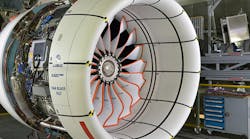GE Aviation, a subsidiary of General Electric Corp. (IW500/6), broke ground in Huntsville, Ala., on two adjacent factories to mass-produce silicon carbide (SiC) materials, to be used to manufacture ceramic matrix composite components (CMCs) for jet engines and land-based gas turbines for electric power. The plants, announced last fall, represent an investment of more than $200 million by the jet-engine manufacturer, which noted they will employ up to 300 people and are expected to be complete in the first half of 2018.
GE Building Two Plants to Produce Ceramic-Matrix Materials
GE Claims Success with CMC for Engine Rotating Parts
One plant will produce SiC ceramic fiber, the first operation to do this in the U.S. The second will use these SiC ceramic fibers to produce unidirectional CMC tape required to fabricate CMC components.
"GE Aviation is creating a fully integrated supply chain for producing CMC components in large volume, which is unique to the United States," stated vice president Sanjay Correa. Correa called the two plants “vital to that effort.
American Machinist is an IndustryWeek companion site within Penton's Manufacturing & Supply Chain Group.



